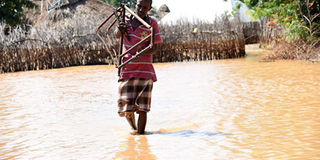Ruling paves way for building of Kenya's largest dam

Floods displace residents of Bandi Village in Tana River County on May 18, 2018. The construction of the high grand falls dam is expected to control flooding in the region. PHOTO | FILE | NATION MEDIA GROUP
What you need to know:
- The plan was conceived in 2009 during former President Mwai Kibaki’s regime as part of an ambitious effort to build 1,000 water reservoirs.
- The dam will also facilitate the irrigation of more than 250,000 hectares of land in Kitui, Garissa and Tana River counties.
Kenya’s ambitious plans to build Africa’s second largest fresh water dam are inching closer to reality after the government resolved a procurement dispute which threatened to delay the project.
The High Grand Falls Dam, estimated to cost a whopping Sh200 billion, is one of the largest undertaking by the government after the Standard Gauge Railway project, and is among President Uhuru Kenyatta’s legacy projects.
It is also part of the Sh1.5 trillion Lamu Port and Southern Sudan-Ethiopia Transport Corridor (Lapsset) projects and will be built downstream the Seven Folks dams along River Tana.
Construction of the dam was conceived in 2009 during former President Mwai Kibaki’s regime as part of an ambitious effort to build 1,000 water reservoirs across the country in an attempt to revolutionise irrigation-based farming.
IRRIGATION
In terms of size, the proposed water reservoir that will cover Kitui and Tharaka Nithi counties will be Africa’s second largest after the Aswan High Dam in Egypt - which is on River Nile - and will be East Africa’s biggest dam covering 165 square kilometres.
Documents seen by the Sunday Nation reveal that construction of the dam that will hold more than 5.6 billion cubic metres of water is expected to take six years, with at least 4,500 households occupying the proposed site in the two counties set to be displaced.
Apart from producing 700 megawatts of hydropower, the dam will also facilitate the irrigation of more than 250,000 hectares of land in Kitui, Garissa and Tana River counties, besides helping address the perennial flooding menace in the Coast region.
According to Irrigation Principal Secretary Fred Segor, the dam’s holding capacity would be enough to support irrigation on a massive scale, address the perennial flooding at the Kenya’s Coast region while also serving 1.5 million people living downstream.
“The benefit to the region is enormous. Because first, it is going to form a large man made lake, where it will be easy introducing fishing and tourism activities to the communities around it,” Prof Segor said.
TENDER
Last week, the Public Procurement Review Board (PPRB) — the state agency that handles disputes arising from government tendering — upheld an earlier ruling that the British firm that won the multibillion contract be allowed to undertake the project.
London-based GBM Engineering Consortium won the tender in a competitive process where seven international construction firms — five of them Chinese — participated in the bidding process under the fund, design, build, own, operate and transfer model.
In the latest ruling, the National Irrigation Board (NIB), which was the procuring entity on behalf of the Kenyan government, was directed to conclude the tendering process within 30 days by carrying out the technical and financial evaluation of the bidders.
Mr Paul Gicheru, the PPRB chairman, ruled that the government had no legal basis of cancelling the tender or delaying the award of the tender to the British firm, after all the other bidders were eliminated at the preliminary stages.
CANCELLED
The board had earlier heard and determined the dispute in favour of the British construction firm on July 4, and was hearing its appeal after the NIB disregarded its ruling and cancelled the tender.
The dispute over tender number NIB/T/018/2016-2017 arose on May 29 when NIB cancelled the tender after it emerged that only GBM Consortium had met the preliminary conditions set out in the request for proposals, including a mandatory site visit.
“The procuring entity is directed to evaluate the tender submitted to it and conclude the procurement process including making the award within 30 days from the date of this decision,” the ruling delivered last week said.
COMPENSATION
This means that plans to rollout the project will begin in earnest after the Treasury agrees with the contractor on the timelines in implementing the project.
Kenya is not required to mobilise any resources for the project as the contractor will operate the dam after construction for a period of 20 years.
The ruling now paves the way for the next phase of land acquisition where affected persons will be relocated.
The Sunday Nation learnt that the British government has a keen interest in the project as it battles for a share of Kenya’s infrastructure deals and was part of agenda discussed during the bilateral talks between Prime Minister Theresa May and Mr Kenyatta in Nairobi last month.





